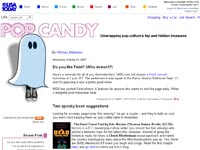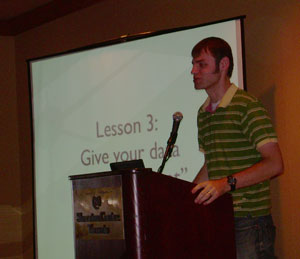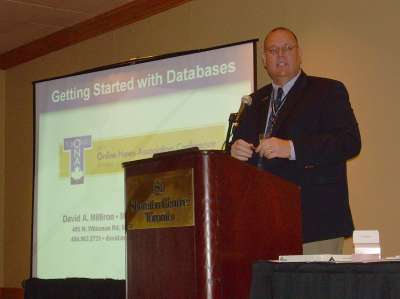 My former competitor, the World’s Ugliest Dog
My former competitor, the World’s Ugliest Dog
Oh, the poor, frail egos of journalists. If low pay, the threat of a shrinking industry and malcontented, loudmouth editors won’t do their self-esteem in, then the most e-mailed lists on their Web sites surely will.
Jon Friedman argues in MarketWatch that news sites should abolish the most e-mailed, most read and most blogged about lists from news sites because they will cause journalists to “lower their standards and write top-40 stories instead of pieces with actual depth.” It also, says Friedman, “reinforces that we’re a nation of gossipmongers and dummies.” (For a more humorous take on this issue, take a look at The Onion‘s “story” back in April: ‘Most E-Mailed’ List Tearing New York Times‘ Newsroom Apart)
With all due sensitivity to journalists’ egos, it’ll be a fun, freewheeling day in the obituaries section before I advocate getting rid of tools such as the most e-mailed/viewed/blog list. Those lists serve as the original way in which readers can “vote” their stories to the top, often circumventing the filters of newsroom editors. The lists serve as a way of spotlighting interesting content long after the unforgiving minute-by-minute news cycle on the Web has pushed it along. It also let’s readers see what other readers are checking out, giving them an alternative way to consume news on the site. And last but certainly not least, it’s just plain interesting to see. It’s part of why news ranking sites such as Digg are so popular.
The real issue is that journalists can’t stand to see stories such as “What Shamu taught me about a happy marriage” become the equivalent of a perpetual hit on the newsroom pop charts while big Sunday snoozer projects, stories about politics and other Serious Stuff barely register a blip. It boils their ego-rich blood.
The answer is not doing something so foolish as abolishing the most viewed list. The solution to this particular pickle is educating the newsroom to understand metrics a little better.
Many journalists don’t realize (or forget when they see these lists) that the most viewed list is a representation of an audience that reaches far beyond the circulation area of the newspaper or viewership area of the TV station. It also doesn’t show how long a person took with the story nor who exactly read that story. I hate to sound like an elitist, but wouldn’t you feel better about your story if a senator read and reacted to it as opposed to if your average Joe did the same?
Back in August of 2005, I wrote a story for the Sun-Sentinel titled ‘Thefts from cars among top crimes’, which took a look at how thieves break into cars and what readers could do to avoid this particular crime. It turned out to be a popular story. But August also marked the rise of the so-called “World’s Ugliest Dog.” It was to be an epic struggle.
The World’s Ugliest Dog and my car-theft story duked it out for the title of Most E-Mailed Story. I climbed to the top of the list first. Then the hideous little fiend inched me out. Then, in a surprising turnaround, my story knocked him down a spot. Alas, when the next day came, the repulsive canine had permanently bumped me from the top, where he remained “top dog” for several weeks.
But I wasn’t offended. I had been “hip to the Web” so to speak and understood that interest for the ugly dog’s ran far beyond the corridors of Broward and Palm Beach County. I also had seen quite a few metrics reports before and had a more balanced understanding of what becomes popular on the site. Lastly, I knew my story was helping the readers who viewed it in a very real way. Those readers most likely spent way more time on the site reading my story then examining the dog. They e-mailed my story to their friends likely because they thought reading it would help their pals too.
The lesson is that the “top” lists on news sites should be taken with a grain of salt — but they should definitely be taken. Editors dare not ignore page view reports, time spent, visitor paths and other critical metrics. They must receive and read them regularly so that they’re not shocked by outliers. They have to understand what works and what doesn’t on the Web, even if it’s more art than science. If that affects our journalistic sensibilities, well, too bad. It simply is not an option to close our eyes and ignore the interests of our readers — prurient though they may occasionally be.This doesn’t mean our whole news site needs to be composed of frivolous content. When an item like the Shamu story or the ugliest dog occasionally bubbles to the top, we tend to ignore the hordes of other “serious” news that our readers find interesting. Just because we consume page view metrics doesn’t mean we need to perpetually pander to the lowest common denominator of the public’s interest. Do readers want our site to be a showcase of Britney Spears and animal freaks?
Despite what our metrics occasionally say, do you in your heart really believe that is what our loyal readers want our news sites to become?
 Hey folks, just a quick heads-up that the new Poynter column WebSpeak is now being offered up via RSS. Woot!
Hey folks, just a quick heads-up that the new Poynter column WebSpeak is now being offered up via RSS. Woot! First, the Allentown Morning Call
First, the Allentown Morning Call 
 Shawn Smith over at
Shawn Smith over at  [UPDATE: A spot check of the WaPo and LA Times shows their PageRank have returned to normal. Oh well, it was fun while it lasted!]
[UPDATE: A spot check of the WaPo and LA Times shows their PageRank have returned to normal. Oh well, it was fun while it lasted!]
 The New York Times
The New York Times  Live from the ONA conference in Toronto…
Live from the ONA conference in Toronto… Live from the ONA conference in Toronto…
Live from the ONA conference in Toronto… Live from the ONA conference in Toronto…
Live from the ONA conference in Toronto…